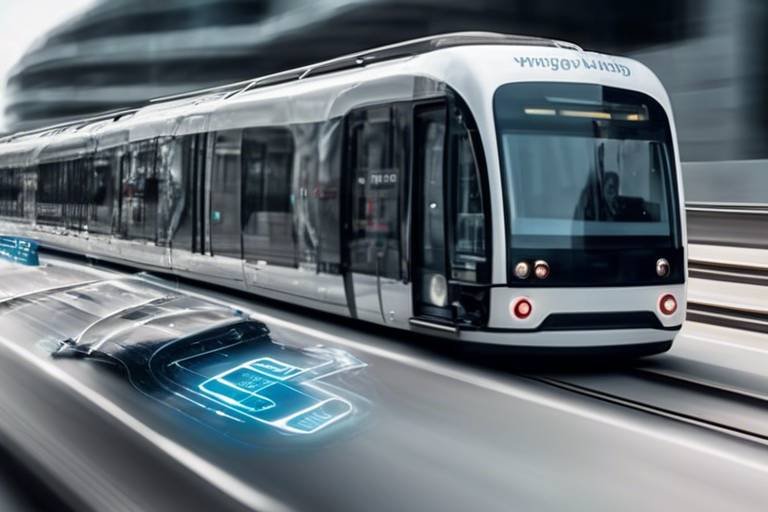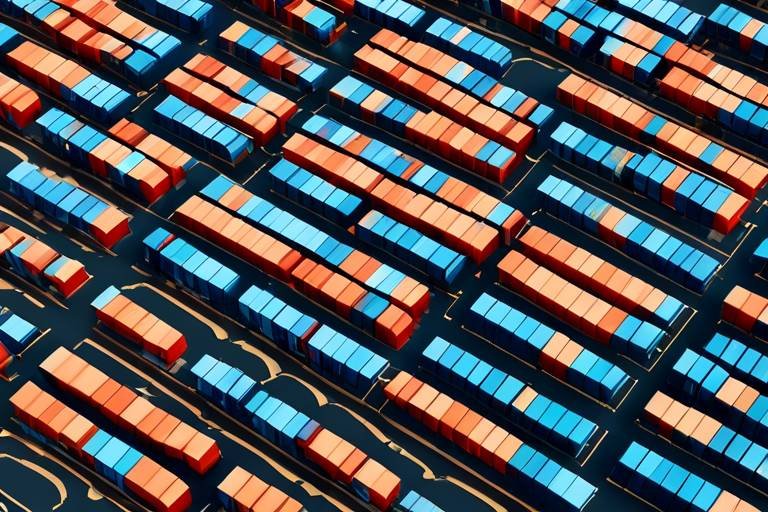How Smart Technologies are Enhancing Transportation
In today's fast-paced world, the way we move from one place to another is undergoing a dramatic transformation, thanks to the rapid advancements in smart technologies. These innovations are not just reshaping the transportation landscape; they are redefining our entire experience as commuters. Imagine a world where traffic jams are a thing of the past, where your vehicle drives itself, and where public transport is as efficient as a well-oiled machine. Sounds like a scene from a sci-fi movie, right? But it's happening right now. Smart technologies are enhancing transportation by improving efficiency, safety, and user experience, while also addressing the challenges that come with these advancements.
At the heart of this transformation are technologies such as autonomous vehicles, smart traffic management systems, and real-time tracking systems. Each of these components plays a crucial role in making our roads safer and our travel times shorter. For instance, autonomous vehicles are designed to reduce human error, which is a leading cause of accidents. By leveraging sophisticated algorithms and sensors, these self-driving cars can navigate complex road environments with precision. Imagine being able to sit back and read a book or catch up on your favorite show while your car takes you to your destination. It's not just a dream; it's becoming a reality.
On the other hand, smart traffic management systems are utilizing real-time data to optimize traffic flow and reduce congestion. Think about how frustrating it can be to sit in traffic, watching the minutes tick away. With smart systems, traffic signals can adapt to current conditions, ensuring a smoother flow of vehicles. This not only saves time but also reduces emissions, contributing to a cleaner environment. The combination of these technologies is paving the way for a future where transportation is not just about getting from point A to point B, but about doing so in the most efficient and enjoyable way possible.
However, as with any significant change, there are challenges to overcome. Issues such as the high cost of implementation and the need for compatible infrastructure can pose obstacles. Yet, the potential benefits far outweigh these challenges. As cities begin to embrace these smart technologies, we can expect to see a shift in urban mobility that prioritizes not just efficiency, but also safety and user satisfaction. The future of transportation is bright, and smart technologies are leading the way.
- What are smart technologies in transportation? Smart technologies in transportation refer to innovations that enhance the efficiency, safety, and user experience of various modes of transport, including autonomous vehicles and smart traffic management systems.
- How do autonomous vehicles improve safety? Autonomous vehicles reduce human error, which is a significant factor in traffic accidents, by using advanced sensors and algorithms to navigate safely.
- What is smart traffic management? Smart traffic management systems use real-time data to optimize traffic flow, reduce congestion, and improve overall urban mobility.
- What are the benefits of real-time tracking systems? Real-time tracking systems provide live updates on vehicle locations, helping passengers reduce wait times and improve service reliability.

Autonomous Vehicles
Autonomous vehicles are not just a futuristic concept; they are rapidly becoming a reality that is reshaping the transportation landscape. Imagine a world where cars drive themselves, eliminating the stress of traffic jams and the anxiety of navigating busy streets. Self-driving cars utilize a combination of advanced technologies, including artificial intelligence, machine learning, and a plethora of sensors, to operate without human intervention. This remarkable innovation aims to reduce human error, which is responsible for a staggering 94% of accidents, according to the National Highway Traffic Safety Administration (NHTSA).
The technology behind autonomous vehicles relies heavily on sophisticated algorithms that process data from various sensors, such as cameras, radar, and lidar. These sensors create a detailed map of the vehicle's surroundings, allowing it to make decisions in real-time. Picture it as a highly skilled driver who can react to changing conditions faster than the blink of an eye! However, while the benefits are enticing, the journey to fully autonomous transportation is fraught with challenges.
One of the most significant advantages of autonomous vehicles is their potential to improve traffic flow. With vehicles communicating with each other and with traffic management systems, we can expect smoother rides and less congestion. It's like having a perfectly choreographed dance on the road, where every vehicle knows its place and timing. However, the road to this utopia is paved with hurdles, such as regulatory challenges, public skepticism, and the need for robust infrastructure.
Moreover, the societal impact of autonomous vehicles cannot be overstated. They promise to increase mobility for those unable to drive, such as the elderly and disabled. This newfound freedom could dramatically enhance their quality of life. Yet, we must also grapple with the economic implications, including job displacement in driving professions and the need for new skill sets in the workforce.
In conclusion, while autonomous vehicles hold the promise of a safer and more efficient transportation system, we must navigate the complexities of technology, ethics, and societal change. The future of driving is not just about the vehicles themselves but also about the systems and policies we establish to support them. As we move forward, continuous dialogue and innovation will be essential to harness the full potential of autonomous vehicles.
- What are autonomous vehicles? Autonomous vehicles are self-driving cars that use technology to navigate and operate without human input.
- How do they improve safety? By reducing human error, which is a major cause of accidents, autonomous vehicles can potentially lower the number of traffic collisions.
- What challenges do they face? Challenges include regulatory hurdles, public acceptance, and the need for updated infrastructure.
- Will they replace human drivers? While they may replace some driving jobs, they will also create new opportunities in technology and infrastructure development.

Smart Traffic Management
In today's fast-paced world, traffic congestion has become a common nightmare for commuters. Enter smart traffic management systems, a breakthrough in urban mobility that leverages real-time data to optimize traffic flow and minimize delays. Imagine a city where traffic lights adjust themselves based on the number of cars on the road, effectively reducing the time you spend idling. Sounds like something out of a sci-fi movie, right? But this is the reality we are moving toward, and it’s all thanks to innovative technologies that are reshaping how we navigate our cities.
These systems utilize a combination of sensors, cameras, and advanced algorithms to gather data on traffic patterns. By analyzing this data, they can make informed decisions about how to control traffic signals, manage road closures, and even predict congestion before it occurs. The result? A smoother, more efficient travel experience for everyone. In fact, studies have shown that cities implementing smart traffic management can see a reduction in congestion by as much as 30%!
One of the most exciting aspects of smart traffic management is its ability to adapt to real-time conditions. For instance, if an accident occurs on a major road, the system can instantly reroute traffic, changing the timing of traffic lights to accommodate the influx of vehicles on alternate routes. This not only helps in maintaining flow but also enhances safety by preventing bottlenecks that could lead to further accidents. It’s like having a personal traffic guide who knows exactly when to steer you away from trouble!
At the heart of smart traffic management is adaptive signal control technology. This innovative approach adjusts traffic signals based on real-time data, allowing for a dynamic response to changing traffic conditions. Imagine a busy intersection where the green light duration varies depending on the amount of traffic waiting. This technology can significantly enhance traffic efficiency, reducing wait times and improving the overall commuting experience. In fact, cities that have implemented adaptive signal control have reported an average reduction in travel times by 10-20%.
Implementing adaptive signal control comes with a plethora of benefits that extend beyond just reducing travel times. Here are some key advantages:
- Improved Air Quality: By minimizing idling time, these systems help reduce vehicle emissions, contributing to cleaner air.
- Enhanced Safety: By reducing congestion, the likelihood of accidents decreases, making roads safer for everyone.
- Cost-Effectiveness: Although the initial investment can be high, the long-term savings from reduced fuel consumption and improved efficiency can be substantial.
These benefits not only enhance the quality of life for residents but also play a significant role in urban planning, making cities more livable and sustainable.
Despite the numerous advantages, the road to implementing adaptive systems is not without its challenges. One of the primary hurdles is the cost associated with upgrading existing infrastructure. Many cities struggle to find the budget necessary to install the required sensors and technology. Additionally, there is the issue of infrastructure compatibility; older traffic systems may not easily integrate with new technologies, leading to potential complications during the transition. However, with careful planning and investment, these challenges can be overcome, paving the way for smarter, more efficient cities.
Data-driven insights are the backbone of smart traffic management. By utilizing analytics and big data, transportation planners can make informed decisions that enhance the overall efficiency of traffic systems. For example, analyzing traffic patterns over time can help identify peak travel times, enabling cities to allocate resources more effectively. Furthermore, this data can be used to plan future infrastructure projects, ensuring that urban areas can accommodate growing populations and changing travel behaviors.

Adaptive Signal Control
Adaptive signal control technology is a game-changer in the realm of urban traffic management. Unlike traditional traffic signals that operate on fixed timers, adaptive systems dynamically adjust the timing of traffic lights based on real-time traffic conditions. This means that during peak hours, when the streets are bustling with vehicles, the signals can extend green lights to accommodate the flow of cars, while during quieter times, they can minimize wait times for pedestrians and cyclists. Imagine a world where you no longer sit through endless red lights, simply because the system is smart enough to know there’s hardly any traffic. Sounds like a dream, right?
The mechanics behind adaptive signal control involve sophisticated algorithms and sensors installed at intersections. These sensors gather data on vehicle counts, speeds, and even pedestrian activity, feeding this information back to a central system that makes instantaneous decisions. By analyzing this data, the system can optimize traffic patterns, significantly reducing congestion and improving overall traffic efficiency. Studies have shown that cities implementing these systems can see a reduction in travel times by as much as 20-30%. That’s not just a statistic; it’s time saved for commuters, leading to less frustration and more productive days.
One of the standout features of adaptive signal control is its ability to prioritize certain types of traffic. For instance, emergency vehicles can be given precedence, allowing them to navigate through congested areas more effectively. This can be the difference between life and death in critical situations. Additionally, these systems can be programmed to accommodate public transportation, ensuring buses and trams maintain their schedules, which is crucial for keeping urban mobility efficient.
However, implementing adaptive signal control is not without its challenges. The initial setup can be costly, requiring investments in new technology and infrastructure. Furthermore, cities must ensure that the existing traffic management systems are compatible with these advanced technologies. This can lead to logistical hurdles that need to be carefully navigated. Despite these challenges, the long-term benefits of adaptive signal control far outweigh the initial investments. As cities continue to grow and urban populations swell, adapting to these smart technologies becomes not just beneficial, but essential for sustainable urban living.
In summary, adaptive signal control represents a significant leap forward in traffic management, combining technology and data to create a smoother, safer, and more efficient transportation experience. As more cities adopt these systems, we can expect to see not only improved traffic flow but also a reduction in emissions and a better quality of life for urban residents.

Benefits of Adaptive Systems
Implementing adaptive signal control systems brings a myriad of benefits that can significantly enhance urban transportation. First and foremost, these systems are designed to reduce travel times for commuters. By dynamically adjusting traffic signals based on real-time traffic conditions, vehicles can move more smoothly through intersections. Imagine a busy city street where cars are constantly stopping at red lights, only to find that no traffic is coming from the other direction. Adaptive systems eliminate this inefficiency, allowing for a more fluid flow of traffic.
Moreover, the environmental impact of these systems cannot be overlooked. By decreasing the number of stops and starts, adaptive signal control helps to lower vehicle emissions. When cars are idling at red lights, they produce unnecessary pollution. With improved traffic flow, we can expect a notable reduction in greenhouse gas emissions, contributing to improved air quality in urban areas.
Additionally, adaptive systems can enhance safety on the roads. By managing traffic more effectively, the likelihood of accidents can be reduced. For example, fewer sudden stops mean less chance of rear-end collisions. Furthermore, these systems can prioritize emergency vehicles, allowing them to navigate through traffic more efficiently. This means that ambulances, fire trucks, and police cars can respond to emergencies more quickly, potentially saving lives.
In terms of economic benefits, cities that adopt adaptive signal control can see a reduction in congestion-related costs. Traffic congestion leads to lost productivity and increased fuel consumption, which can burden both the economy and the environment. By enhancing traffic efficiency, cities can save money on infrastructure maintenance and improve the overall quality of life for their residents.
To summarize, the benefits of adaptive systems can be categorized as follows:
- Reduced Travel Times: Enhanced flow leads to quicker commutes.
- Lower Emissions: Improved traffic patterns result in less pollution.
- Increased Safety: Fewer accidents due to smoother traffic flow.
- Economic Savings: Reduced costs related to congestion and infrastructure.
In conclusion, the adoption of adaptive signal control technology not only streamlines traffic but also brings substantial benefits to the environment, safety, and the economy. As cities continue to grow and evolve, embracing these smart technologies will be vital for creating sustainable urban environments.
1. What is adaptive signal control?
Adaptive signal control is a traffic management technology that adjusts traffic signal timings in real-time based on current traffic conditions to improve traffic flow and reduce congestion.
2. How does adaptive signal control improve safety?
By optimizing traffic flow and reducing unnecessary stops, adaptive signal control can decrease the likelihood of accidents, particularly at intersections.
3. What are the environmental benefits of adaptive systems?
These systems help lower vehicle emissions by minimizing idling and reducing fuel consumption, contributing to better air quality in urban areas.
4. Are there any challenges in implementing adaptive signal control?
Yes, challenges include the initial costs of installation, the need for compatible infrastructure, and ongoing maintenance of the technology.

Challenges in Implementation
Implementing smart technologies in transportation systems is not without its hurdles. One of the most significant challenges is the cost of investment. Upgrading existing infrastructure to accommodate advanced technologies like adaptive signal control and real-time data analytics can be a hefty financial burden for many cities. This isn't just about installing new equipment; it involves comprehensive planning, training personnel, and potentially overhauling entire systems. The financial implications can lead to resistance from stakeholders who are hesitant to allocate budgets for these transformative projects.
Another challenge is infrastructure compatibility. Many cities are grappling with outdated infrastructure that simply isn’t designed to support modern smart technologies. For instance, older traffic signals may not be able to integrate with new adaptive systems, leading to additional costs for retrofitting or replacing existing equipment. This compatibility issue can create significant delays in implementation timelines, frustrating city planners and residents alike.
Moreover, there is the question of data privacy and security. As smart technologies rely heavily on the collection and analysis of data, concerns about how this data is managed and protected are paramount. Citizens are increasingly aware of their digital footprints, and any hint of misuse or data breaches can lead to public backlash. Therefore, ensuring robust security measures and transparent data usage policies is crucial for gaining public trust.
Finally, there is the challenge of public acceptance. Even the most advanced technology can falter if it lacks public support. Many individuals may be skeptical about the reliability of autonomous vehicles or smart traffic management systems. Public education campaigns and community engagement initiatives are essential to address these concerns and to inform citizens about the benefits of embracing smart transportation technologies.
To summarize, the challenges in implementing smart technologies in transportation systems can be categorized as follows:
- Cost of Investment: High financial requirements for upgrading systems.
- Infrastructure Compatibility: Issues with integrating new technologies into older systems.
- Data Privacy and Security: Concerns over the management and protection of collected data.
- Public Acceptance: The need for community support and trust in new technologies.
While these challenges may seem daunting, they are not insurmountable. With strategic planning, investment in education, and community engagement, cities can successfully navigate these obstacles and pave the way for a smarter, more efficient transportation future.
- What are the main challenges of implementing smart transportation technologies?
The main challenges include high costs of investment, infrastructure compatibility issues, data privacy concerns, and the need for public acceptance.
- How can cities overcome the financial burden of smart technology implementation?
Cities can seek public-private partnerships, government grants, and phased implementation strategies to spread out costs over time.
- Why is public acceptance crucial for smart transportation systems?
Public acceptance is essential because without community support, even the best technologies can struggle to gain traction and be effectively utilized.

Data-Driven Insights
In today's fast-paced world, are becoming the backbone of smart traffic management systems. Imagine a bustling city where every traffic light, bus route, and commuter's path is optimized in real-time. This is not just a fantasy; it's the reality that smart technologies are bringing to our urban landscapes. By harnessing the power of big data and advanced analytics, cities can make informed decisions that enhance transportation efficiency and improve the overall user experience.
The beauty of data-driven insights lies in their ability to analyze vast amounts of information from various sources. For instance, traffic cameras, sensors, and GPS data from vehicles can be integrated to create a comprehensive picture of traffic patterns. This data can reveal trends such as peak travel times, accident hotspots, and areas prone to congestion. With this knowledge, city planners and traffic management systems can implement changes that significantly reduce travel times and enhance safety.
One of the most exciting aspects of data-driven insights is their ability to facilitate predictive analytics. By analyzing historical data, smart systems can forecast traffic conditions and adjust traffic signals or reroute public transport accordingly. For example, if data indicates a major sporting event is about to conclude, the system can prepare for the influx of vehicles by adjusting traffic signals in real-time to accommodate the expected surge. This proactive approach not only improves flow but also enhances the overall commuting experience for everyone.
Moreover, the integration of real-time data allows for immediate responses to unforeseen circumstances, such as accidents or road closures. Consider this: if a major accident occurs on a busy highway, data-driven systems can quickly analyze the situation and reroute traffic, minimizing delays and preventing further incidents. This level of responsiveness is crucial in maintaining the safety and efficiency of urban transportation networks.
However, it's essential to note that while the benefits of data-driven insights are immense, they come with their own set of challenges. Issues such as data privacy, security, and the need for robust infrastructure must be addressed to fully realize the potential of these technologies. Cities must ensure that they comply with regulations and protect the personal information of their citizens while still leveraging data for improved transportation systems.
As we look to the future, the role of data-driven insights in transportation will only continue to grow. The potential for smart cities is vast, with opportunities for enhanced public safety, reduced environmental impact, and improved quality of life for residents. By embracing these technologies, cities can create a more efficient and enjoyable transportation experience for all.
- What are data-driven insights in transportation?
Data-driven insights refer to the analysis of large datasets to inform and improve transportation systems, helping to optimize traffic flow and enhance user experience. - How do smart technologies improve traffic management?
Smart technologies utilize real-time data to make informed decisions about traffic signals, routes, and public transport, leading to reduced congestion and improved safety. - What challenges do cities face when implementing data-driven systems?
Challenges include data privacy concerns, the need for substantial infrastructure investments, and ensuring the security of the data collected.

Smart Public Transportation
In recent years, the landscape of public transportation has undergone a remarkable transformation, thanks to the integration of smart technologies. These innovations are not just about making buses and trains run; they’re about creating a seamless experience for passengers. Imagine stepping onto a bus that you can track in real-time, knowing exactly when it will arrive, or using an app that allows you to pay for your ride with a simple tap on your phone. This is the power of smart public transportation, and it’s changing the way we think about commuting.
One of the standout features of smart public transportation systems is mobile ticketing. Gone are the days of fumbling for coins or waiting in line to purchase a ticket. With mobile apps, passengers can buy their tickets on the go, eliminating the hassle and saving precious time. These applications often come equipped with a variety of features that enhance the overall user experience, such as:
- Real-time updates: Passengers receive notifications about delays and changes in schedules.
- Route planning: Users can find the fastest routes and connections based on current conditions.
- Payment options: Multiple payment methods, including credit cards and digital wallets, are supported.
Moreover, the advent of real-time tracking systems has further revolutionized public transportation. These systems provide live updates on vehicle locations, allowing passengers to plan their journeys more effectively. Imagine standing at a bus stop and knowing exactly when your bus will arrive—no more guessing or waiting in uncertainty! This not only reduces wait times but also enhances service reliability, making public transport a more attractive option for daily commuters.
But the benefits don’t stop there. Smart public transportation systems are also designed with sustainability in mind. By optimizing routes and reducing idle times through data-driven insights, these technologies help lower emissions and promote a greener environment. As cities grow and populations swell, the need for efficient and eco-friendly transportation solutions becomes increasingly critical.
However, implementing these smart technologies isn’t without its challenges. Infrastructure upgrades, initial costs, and the need for public buy-in can pose significant hurdles. Cities must work collaboratively with technology providers and engage with communities to ensure these systems meet the needs of all users. The journey to a fully integrated smart public transportation system is ongoing, but the potential rewards are immense.
- What are smart public transportation systems?
- Smart public transportation systems utilize technology to enhance the efficiency, reliability, and user experience of public transit. This includes features like real-time tracking, mobile ticketing, and data analytics.
- How do real-time tracking systems work?
- Real-time tracking systems use GPS and data analytics to provide live updates on vehicle locations, allowing passengers to know exactly when their transport will arrive.
- What are the benefits of mobile ticketing?
- Mobile ticketing simplifies the ticket purchasing process, reduces wait times, and provides passengers with convenient payment options, enhancing their overall experience.
- Are there any challenges in implementing smart public transportation?
- Yes, challenges include high initial costs, the need for infrastructure upgrades, and ensuring public acceptance and engagement with new technologies.

Mobile Applications
Mobile applications have become the backbone of modern public transportation systems, transforming how passengers interact with transit services. Imagine waiting at a bus stop, only to realize that the bus is running late or, even worse, that you missed it entirely! With the advent of smart mobile apps, such scenarios are becoming a thing of the past. These applications provide real-time information that empowers users to make informed decisions about their travel plans, ultimately enhancing their overall experience.
One of the standout features of these mobile applications is the ability to purchase tickets digitally. Gone are the days of fumbling for change or standing in line at a ticket booth. With just a few taps on their smartphones, passengers can buy tickets, check schedules, and even manage their accounts. This convenience not only saves time but also reduces the need for physical cash transactions, making the entire process smoother and more efficient.
Moreover, mobile applications often come equipped with real-time tracking systems. Passengers can see exactly where their bus or train is at any given moment, allowing them to plan their arrival at the station with precision. This feature significantly reduces the anxiety associated with waiting for public transport. Instead of guessing whether the next bus is five minutes away or twenty, users can track its location in real-time. This transparency fosters a sense of control and enhances user satisfaction.
Additionally, many apps incorporate user-friendly interfaces that cater to a wide range of passengers, including those who may not be tech-savvy. For instance, features like voice commands and easy navigation menus ensure that everyone can utilize the app effectively. By making technology accessible, these applications are democratizing public transport, ensuring that no one is left behind.
Furthermore, mobile applications often include personalized notifications that keep users informed. Imagine receiving a notification that your bus is arriving in 5 minutes or that there’s a service disruption on your usual route. This proactive communication helps passengers adjust their plans accordingly, reducing frustration and improving their overall travel experience.
In summary, mobile applications are not just a trend; they are a vital component of modern public transportation. By offering features like digital ticketing, real-time tracking, user-friendly interfaces, and personalized notifications, these apps are enhancing the way we travel. As technology continues to evolve, we can only expect these applications to become even more sophisticated, further revolutionizing public transport systems around the globe.
- What features should I look for in a public transportation app?
Look for features like real-time tracking, digital ticket purchasing, user-friendly design, and personalized notifications to enhance your travel experience. - Are mobile applications safe to use for purchasing tickets?
Yes, most public transportation apps use secure payment gateways to ensure that your transactions are safe and your personal information is protected. - Can I use these apps for multiple forms of transportation?
Many apps integrate various modes of transport, allowing you to plan your journey across buses, trains, and even rideshare services seamlessly.

Real-Time Tracking Systems
Imagine standing at a bus stop, anxiously checking your watch as the minutes tick by. You’ve got places to be, and the uncertainty of when your ride will arrive can be frustrating. This is where come into play, revolutionizing the way we interact with public transportation. These systems provide passengers with live updates on vehicle locations, allowing them to plan their journeys more effectively and reduce wait times.
At the heart of real-time tracking is a combination of GPS technology and mobile applications. Buses, trains, and other transit vehicles are equipped with GPS devices that send their location data back to a central system. This information is then processed and made available to passengers through various platforms, including mobile apps and digital displays at transit stations. By knowing exactly when their next ride will arrive, passengers can make informed decisions about when to leave their homes or workplaces.
One of the most significant impacts of real-time tracking systems is the enhancement of service reliability. For instance, consider a scenario where a bus is delayed due to traffic. With real-time tracking, passengers can receive instant notifications about the delay, allowing them to adjust their plans accordingly. This not only improves the overall user experience but also builds trust in public transportation systems, encouraging more people to ditch their cars in favor of buses and trains.
Moreover, real-time tracking contributes to operational efficiency for transit agencies. By analyzing data on vehicle locations and passenger loads, agencies can optimize routes and schedules. This data-driven approach ensures that resources are allocated where they are needed most, leading to reduced operational costs and improved service frequency. In essence, real-time tracking systems create a win-win situation for both passengers and transit operators.
However, the implementation of these systems is not without its challenges. The integration of technology into existing infrastructure can be complex and costly. Additionally, ensuring data accuracy and system reliability is crucial; if the tracking data is incorrect, it can lead to confusion and frustration among passengers. Despite these hurdles, the benefits of real-time tracking systems are undeniable, and as technology continues to evolve, we can expect even more innovative solutions to emerge in the public transportation sector.
- How do real-time tracking systems work? Real-time tracking systems use GPS technology to monitor the location of transit vehicles and relay that information to passengers through mobile apps and displays.
- What are the benefits of using real-time tracking? Benefits include reduced wait times, improved service reliability, and enhanced operational efficiency for transit agencies.
- Are there any challenges in implementing these systems? Yes, challenges include integration with existing infrastructure, costs, and ensuring data accuracy.
Frequently Asked Questions
- What are autonomous vehicles and how do they work?
Autonomous vehicles, often referred to as self-driving cars, utilize a combination of sensors, cameras, and artificial intelligence to navigate roads without human intervention. They analyze their surroundings in real-time, making decisions based on data collected from their environment, which helps in reducing human error and improving traffic flow.
- How does smart traffic management improve urban mobility?
Smart traffic management systems leverage real-time data to optimize traffic flow, reducing congestion and travel times. By analyzing traffic patterns and adjusting signals accordingly, these systems enhance the overall efficiency of transportation networks, making cities more navigable for everyone.
- What is adaptive signal control and its benefits?
Adaptive signal control technology modifies traffic signal timings based on current traffic conditions. This means that if there's a sudden increase in vehicles at a particular intersection, the system can adjust the signals to minimize wait times. The benefits include reduced travel times, improved air quality, and a smoother flow of traffic.
- What challenges are faced in implementing adaptive systems?
While adaptive signal control offers numerous advantages, some challenges include high implementation costs, the need for compatible infrastructure, and the integration of new technologies with existing systems. Addressing these challenges requires careful planning and investment from city planners and policymakers.
- How do data-driven insights enhance transportation planning?
Data-driven insights utilize analytics and big data to inform decision-making in transportation planning. By analyzing trends and patterns, city planners can make more informed choices about where to allocate resources, improve services, and enhance the overall user experience in public transportation.
- What innovations are improving public transportation?
Innovations such as mobile ticketing, real-time tracking, and user-friendly mobile applications are significantly enhancing public transportation systems. These technologies make it easier for passengers to access services, purchase tickets, and receive live updates on vehicle locations, ultimately improving the overall user experience.
- How do mobile applications benefit public transport users?
Mobile applications provide passengers with essential features like route planning, ticket purchasing, and real-time updates on vehicle locations. This convenience means less waiting and more efficient travel, making public transport a more attractive option for commuters.
- What impact do real-time tracking systems have on service reliability?
Real-time tracking systems offer passengers live updates on vehicle locations, which helps reduce uncertainty and wait times. This transparency not only improves user satisfaction but also encourages more people to use public transportation, leading to a more sustainable urban mobility solution.



















